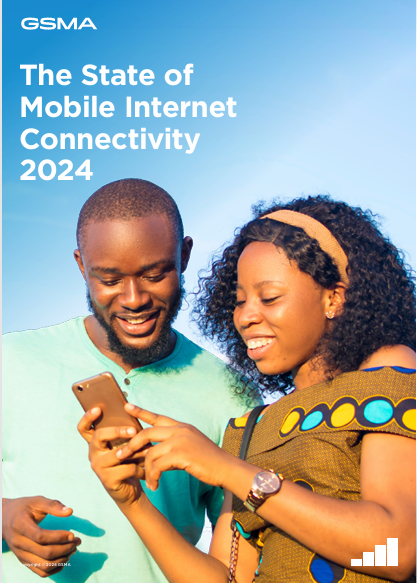More people than ever before are now accessing the internet through mobile devices.
By the end of 2023, mobile internet users increased to 4.6 billion people (57% of the global population). However, the growth rate at which people are adopting mobile internet has remained flat, and significant digital divides persist. Closing these digital divides brings significant socioeconomic benefits and is more crucial than ever.
Despite the benefits of connectivity, 39% of the global population are living within mobile broadband coverage but are not using it – the usage gap. Furthermore, 4% are still not covered by mobile broadband – the coverage gap.
The State of Mobile Internet Connectivity Report 2024 provides the mobile industry and other stakeholders with a comprehensive overview of the trends in global connectivity, as well as insights on key barriers to mobile internet adoption.
For the first time, it also includes an analysis of the barriers to further use of mobile internet, connectivity among children, and the economic impact of closing the usage gap. It also outlines recommendations for tackling the persistent gaps to digital inclusion.
Further country-level data can be found in the GSMA Mobile Connectivity Index, a tool that measures the performance of 173 countries against the key enablers of mobile internet adoption:
- infrastructure
- affordability
- consumer readiness
- content and services.
The Index was developed as part of the mobile industry’s commitment to drive mobile internet connectivity and accelerate digital inclusion.
Key findings:
1. Mobile internet adoption continues to increase, with 57% of the world's population (4.6 billion people) now using mobile internet on their own devices. However, the growth rate at which people are adopting mobile internet remained flat in 2023. Around 160 million people started using mobile internet in 2023, which is similar to the growth in 2022 but represents a slowdown compared to 2015–2021 when more than 200 million people became connected each year. More than 90% of the growth in 2023 came from low- and middle-income countries (LMICs), where 95% of the unconnected population lives.
2. With the vast majority of the world’s population living within the footprint of a mobile broadband network, mobile broadband coverage only increased marginally. Of the global population, 96% is now covered by mobile broadband, with the remaining the hardest to reach. Those living in areas without mobile broadband coverage – the coverage gap – total around 350 million people (4% of the world’s population). The coverage gap is more pronounced in some countries, with 31 countries still having a coverage gap larger than 10% of the population. Uncovered communities are predominantly rural, poor, and sparsely populated. They are typically in the least developed country (LDC), landlocked developing country (LLDC), or small island developing state (SIDS).
3. Almost 90% of those not using mobile internet live in areas covered by mobile broadband. There were 3.1 billion people (39% of the global population) living in areas covered by mobile internet but not using it by the end of 2023. With mobile internet adoption outpacing network expansion, this usage gap has continued to shrink. However, the usage gap is now nine times the size of the coverage gap. Two thirds of those who are not using mobile internet despite living in areas where there is broadband coverage do not yet own a mobile phone of any type.
4. Connectivity varies significantly by and within regions and countries, with 95% of those not using mobile internet living in LMICs. As in previous years, Sub-Saharan Africa remains the region with the largest coverage and usage gaps. In LMICs, adults in rural areas are 28% less likely than those living in urban areas to use mobile internet, and women are 15% less likely than men to use mobile internet. Among LMICs, connectivity tends to be significantly lower in LDCs, LLDCs and SIDS.
5. The number of people using their own smartphone to access the internet increased to almost 4.3 billion people by the end of 2023 (53% of the global population). Almost 80% of mobile internet subscribers globally are now accessing the internet on a 4G or 5G smartphone – an increase of 330 million people between 2022 and 2023. While this represents a significant increase, one in five mobile internet subscribers worldwide are still using a 3G smartphone or feature phone to access the internet. This reaches more than a third in Latin America & the Caribbean and MENA, and almost two-thirds in Sub-Saharan Africa.
6. A further 730 million individuals used mobile internet in 2023 on a device they do not own or have primary use of. This comprises 440 million adults and 290 million children under 18 years old. While access on a shared or other person’s device represents an important mode of access for many children, it is more limiting for adults; they are unable to realize the full benefits of mobile internet if they only have temporary, shared or intermittent access.
7. 4G is approaching 3G levels of coverage, but the majority of network investment continues to be in 5G deployment. At the end of 2023, the number of 5G connections worldwide exceeded 1.5 billion. However, more than 100 countries have not launched 5G networks yet, with more than 80% of these LMICs.
8. Network quality and data consumption in LMICs have seen the largest increases to date, but significant gaps persist versus high-income regions. With more consumers migrating to 4G and 5G, average data traffic per user continues to increase, reaching almost 13 GB per connection in 2023. Global average download speeds have also increased – from 34 to 48 Mbps. While average download speeds in high-income countries reached almost 100 Mbps, they remain below 20 Mbps in LDCs, LLDCs and SIDS.
9. Mobile internet awareness continues to grow but in many cases remains a significant barrier to mobile internet adoption. In 2023, more than 80% of the population in seven of the 12 surveyed countries were aware of mobile internet. However, this still means that in five of the survey countries, 20–50% of the population has still not heard of mobile internet. Women and those living in rural areas also remain less likely to be aware.
10. For those already aware of mobile internet, the top-reported barriers to adoption are affordability (primarily of handsets) and literacy & digital skills. Affordability (particularly of internet-enabled handsets) remains the greatest barrier to mobile internet adoption across the countries surveyed, especially in Sub-Saharan Africa. Lack of literacy and digital skills ranked second overall across the countries surveyed and is the top barrier to mobile internet adoption across Asian countries. Safety and security concerns and lack of perceived relevance were reported less often but are also important barriers.
11. While most mobile internet users use it every day, usage is often limited to only one or two activities, and many say they want to use it more. Communications, social media, and entertainment remain the most popular activities. However, the use of other activities is lower and is much more varied across countries. Across the survey countries, an average of 43% of mobile internet users reported wanting to use it more. The top barriers to further use vary by country, but commonly reported barriers are safety and security concerns, affordability (particularly of data but also handsets), and the connectivity experience.
12. Affordability of an entry-level, internet-enabled handset remained relatively unchanged, while affordability of data continues to improve in LMICs across most regions. However, the affordability of devices and data continues to disproportionately affect the underserved. Across LMICs, the affordability of an entry-level handset is 18% of average monthly income overall. However, it is equivalent to 39% of average monthly income for the poorest 40%, and 51% for the poorest 20%. In Sub-Saharan Africa, which accounts for a quarter of the unconnected population worldwide, an entry-level device costs 99% of average monthly income for the poorest 20%. For women in LMICs, the cost of an entry-level, internet-enabled handset is 24% of monthly income, compared to 12% for men.
13. Closing the usage gap is estimated to add $3.5 trillion in total additional GDP during 2023–2030. More than 90% of this benefit ($3.2 trillion) would accrue to LMICs, given they account for the vast majority of the unconnected. Just over $1.3 trillion in total additional GDP over the period would come from closing the gender gap in mobile internet adoption across LMICs.
Download the full report: https://www.gsma.com/r/somic/



.jpg)


